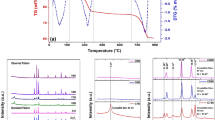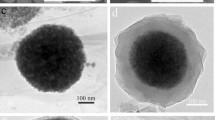Abstract
In this work, a bimetallic zeolitic imidazolate framework (ZIF) CoZn-ZIF was synthesized via a facile solvothermal approach and applied in lithium-ion batteries. The as-prepared CoZn-ZIF shows a high reversible capacity of 605.8 mA h g−1 at a current density of 100 mA g−1, far beyond the performance of the corresponding monometallic Co-ZIF- 67 and Zn-ZIF-8. Ex-situ synchrotron soft X-ray absorption spectroscopy, X-ray diffraction, and electron paramagnetic resonance techniques were employed to explore the Li-storage mechanism. The superior performance of CoZn-ZIF over Co- ZIF-67 and Zn-ZIF-8 could be mainly attributed to lithiation and delithiation of nitrogen atoms, accompanied by the breakage and recoordination of metal nitrogen bond. Morever, a few metal nitrogen bonds without recoordination will lead to the amorphization of CoZn-ZIF and the formation of few nitrogen radicals.
摘要
本文首次水热合成了一种双金属沸石咪唑有机框架(CoZn-ZIF)并将其用于锂离子电池负极. 该材料在以100 mA g−1电流充放电时, 具有605.8 mA h g−1的可逆容量, 远远大于同类单金属材料(Co-ZIF-67和Zn-ZIF-8). 为了探知该高容量来源, 我们进行了一系列非原位实验, 包括同步辐射软线、 粉末衍射、 透射电镜以及顺磁共振. 研究表明该双金属高容量主要得益于配位氮原子参与锂化反应, 在这一过程中还伴随了金属氮配位键的打开与重新配合. 另外, 少量金属氮配位键的不可逆反应会导致该材料晶体的无序化以及一些氮自由基的生成. 这种高活性双金属的设计思路和反应机理可推广到包括催化、 气体吸附等的其他应用中.
Similar content being viewed by others
References
Armand M, Tarascon JM. Building better batteries. Nature, 2008, 451: 652–657
Tarascon JM, Armand M. Issues and challenges facing rechargeable lithium batteries. Nature, 2001, 414: 359–367
Zhou HC, Long JR, Yaghi OM. Introduction to metal–organic frameworks. Chem Rev, 2012, 112: 673–674
Zhu QL, Xu Q. Metal–organic framework composites. Chem Soc Rev, 2014, 43: 5468–5512
Dou Y, Zhou J, Zhou A, et al. Visible-light responsive MOF encapsulation of noble-metal-sensitized semiconductors for high-performance photoelectrochemical water splitting. J Mater Chem A, 2017, 5: 19491–19498
Zhou J, Dou Y, Zhou A, et al. MOF template-directed fabrication of hierarchically structured electrocatalysts for efficient oxygen evolution reaction. Adv Energy Mater, 2017, 7: 1602643
Gou L, Hao LM, Shi YX, et al. One-pot synthesis of a metal–organic framework as an anode for Li-ion batteries with improved capacity and cycling stability. J Solid State Chem, 2014, 210: 121–124
Hu X, Hu H, Li C, et al. Cobalt-based metal organic framework with superior lithium anodic performance. J Solid State Chem, 2016, 242: 71–76
Hu H, Lou X, Li C, et al. A thermally activated manganese 1,4-benzenedicarboxylate metal organic framework with high anodic capability for Li-ion batteries. New J Chem, 2016, 40: 9746–9752
Lou X, Hu H, Li C, et al. Capacity control of ferric coordination polymers by zinc nitrate for lithium-ion batteries. RSC Adv, 2016, 6: 86126–86130
Jin Y, Zhao C, Sun Z, et al. Facile synthesis of Fe-MOF/RGO and its application as a high performance anode in lithium-ion batteries. RSC Adv, 2016, 6: 30763–30768
Maiti S, Pramanik A, Manju U, et al. Reversible lithium storage in manganese 1,3,5-benzenetricarboxylate metal–organic framework with high capacity and rate performance. ACS Appl Mater Interfaces, 2015, 7: 16357–16363
Li C, Lou X, Shen M, et al. High anodic performance of Co 1,3,5-benzenetricarboxylate coordination polymers for Li-ion battery. ACS Appl Mater Interfaces, 2016, 8: 15352–15360
Maiti S, Pramanik A, Manju U, et al. Cu3(1,3,5-benzenetricarboxylate) 2 metal-organic framework: A promising anode material for lithium-ion battery. Micropor Mesopor Mater, 2016, 226: 353–359
Hu X, Lou X, Li C, et al. Facile synthesis of the Basolite F300-like nanoscale Fe-BTC framework and its lithium storage properties. RSC Adv, 2016, 6: 114483–114490
Li T, Li C, Hu X, et al. Reversible lithium storage in manganese and cobalt 1,2,4,5-benzenetetracarboxylate metal–organic framework with high capacity. RSC Adv, 2016, 6: 61319–61324
Li C, Hu X, Lou X, et al. The organic-moiety-dominated Li+ intercalation/deintercalation mechanism of a cobalt-based metal–organic framework. J Mater Chem A, 2016, 4: 16245–16251
Gong T, Lou X, Gao EQ, et al. Pillared-layer metal–organic frameworks for improved lithium-ion storage performance. ACS Appl Mater Interfaces, 2017, 9: 21839–21847
Ning Y, Lou X, Li C, et al. Ultrathin cobalt-based metal-organic framework nanosheets with both metal and ligand redox activities for superior lithium storage. Chem Eur J, 2017, 23: 15984–15990
Zheng F, Yang Y, Chen Q. High lithium anodic performance of highly nitrogen-doped porous carbon prepared from a metal-organic framework. Nat Commun, 2014, 5: 5261
Han Y, Qi P, Li S, et al. A novel anode material derived from organic-coated ZIF-8 nanocomposites with high performance in lithium ion batteries. Chem Commun, 2014, 50: 8057–8060
Zhang G, Hou S, Zhang H, et al. High-performance and ultrastable lithium-ion batteries based on MOF-derived ZnO@ZnO quantum dots/C core-shell nanorod arrays on a carbon cloth anode. Adv Mater, 2015, 27: 2400–2405
Cheng F, Li WC, Zhu JN, et al. Designed synthesis of nitrogen-rich carbon wrapped Sn nanoparticles hybrid anode via in-situ growth of crystalline ZIF-8 on a binary metal oxide. Nano Energy, 2016, 19: 486–494
Mao Y, Li G, Guo Y, et al. Foldable interpenetrated metal-organic frameworks/carbon nanotubes thin film for lithium–sulfur batteries. Nat Commun, 2017, 8: 14628
Li Z, Huang X, Sun C, et al. Thin-film electrode based on zeolitic imidazolate frameworks (ZIF-8 and ZIF-67) with ultra-stable performance as a lithium-ion battery anode. J Mater Sci, 2017, 52: 3979–3991
Lin Y, Zhang Q, Zhao C, et al. An exceptionally stable functionalized metal–organic framework for lithium storage. Chem Commun, 2015, 51: 697–699
Li C, Hu X, Lou X, et al. Bimetallic coordination polymer as a promising anode material for lithium-ion batteries. Chem Commun, 2016, 52: 2035–2038
Wu S, Zhu Y, Huo Y, et al. Bimetallic organic frameworks derived CuNi/carbon nanocomposites as efficient electrocatalysts for oxygen reduction reaction. Sci China Mater, 2017, 60: 654–663
An X, Yang H, Wang Y, et al. Hydrothermal synthesis of coherent porous V2O3/carbon nanocomposites for high-performance lithium-and sodium-ion batteries. Sci China Mater, 2017, 60: 717–727
Hachuła B, Nowak M, Kusz J. Crystal and molecular structure analysis of 2-methylimidazole. J Chem Crystlogr, 2010, 40: 201–206
Zhou K, Mousavi B, Luo Z, et al. Characterization and properties of Zn/Co zeolitic imidazolate frameworks vs. ZIF-8 and ZIF-67. J Mater Chem A, 2017, 5: 952–957
Kaur G, Rai RK, Tyagi D, et al. Room-temperature synthesis of bimetallic Co–Zn based zeolitic imidazolate frameworks in water for enhanced CO2 and H2 uptakes. J Mater Chem A, 2016, 4: 14932–14938
Jiang Y, Zhang D, Li Y, et al. Amorphous Fe2O3 as a high-capacity, high-rate and long-life anode material for lithium ion batteries. Nano Energy, 2014, 4: 23–30
Guo CS, Sun L, Hermann K, et al. X-ray absorption from large molecules at metal surfaces: Theoretical and experimental results for Co-OEP on Ni(100). J Chem Phys, 2012, 137: 194703–194703
Acknowledgements
This work was supported by the National Natural Science Foundation of China for Excellent Young Scholars (21522303), the National Natural Science Foundation of China (21373086), the Basic Research Project of Shanghai Science and Technology Committee (14JC1491000), the Large Instruments Open Foundation of East China Normal University, the National Key Basic Research Program of China (2013CB921800) and the National High Technology Research and Development Program of China (2014AA123401). We acknowledge the support from the National Synchrotron Radiation Laboratory (NSRL) for the sXAS experiments. We also thank Dr. Jiahui Yang from Bruker for the support of EPR measurements and analysis.
Author information
Authors and Affiliations
Corresponding author
Additional information
Xiaobing Lou is a PhD student at the East China Normal University. His research interests are design of metal organic frameworks and their electrochemical application, with a specific focus on the mechanism research by means of magnetic resonance technique.
Bingwen Hu received his PhD degree in 2009 from National High field NMR Center, Université Lille 1, France. After that, he returned to East China Normal University and started his career as a research scientist. Now, he is a professor scientist at the Shanghai Key Laboratory of Magnetic Resonance and adjunct professor at the State Key Laboratory of Precision Spectroscopy at East China Normal University. His research interests include new method development in solid state NMR, and the application of NMR and EPR for batteries. He has published more than one hundred papers in refereed journals.
Electronic supplementary material
40843_2017_9200_MOESM1_ESM.pdf
Bimetallic zeolite imidazolate framework for enhanced lithium storage boosted by the redox participation of nitrogen atoms
Rights and permissions
About this article
Cite this article
Lou, X., Ning, Y., Li, C. et al. Bimetallic zeolite imidazolate framework for enhanced lithium storage boosted by the redox participation of nitrogen atoms. Sci. China Mater. 61, 1040–1048 (2018). https://doi.org/10.1007/s40843-017-9200-5
Received:
Accepted:
Published:
Issue Date:
DOI: https://doi.org/10.1007/s40843-017-9200-5




